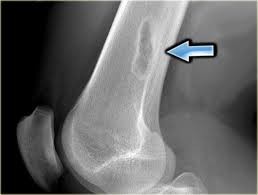September 13, 2015 – Fifteen percent of patients treated with calcium sulfate/tricalcium phosphate cementing after curettage and grafting of low-grade bone lesions developed unexpected radiographic lucency (URL) in a retrospective comparative study.1
The study was designed to report the development of unexpected radiographic lucency (URL) corresponding to the use of a commercially available calcium sulfate/tricalcium phosphate composite used to treat benign osseous lesions.
The charts of 87 patients meeting the inclusion criteria were reviewed for demographic, clinical, and radiographic data. Thirteen of 87 cases (15%) showed URL. The findings showed that the majority of patients went on to uneventful healing. Although URL occured in lieu of the more typical pattern of centripetal incorporation in a minority of patients, there is no increase in complications associated with URL.

Image: NOF is a benign well-defined, solitary lesion due to proliferation of fibrous tissue. It is the most common bone lesion.2
The authors concluded that patients should be informed of the possibility of this risk, although there appears to be little risk of clinically relevant adverse consequences. Physicians should be aware of this complication in order to avoid mistaking it for recurrence of the primary lesion.
Source:
1. Auston DA, Feiber M, Craig T, Damron TA.Unexpected radiographic lucency following grafting of bone defects with calcium sulfate/tricalcium phosphate bone substitute. October 2015, Volume 44, Issue 10, pp 1453-1459.
2. The Radiology Assistant: Bone Tumor. http://www.radiologyassistant.nl/en/p4bc6176e56228/bone-tumor-well-defined-osteolytic-tumors-and-tumor-like-lesions.html




